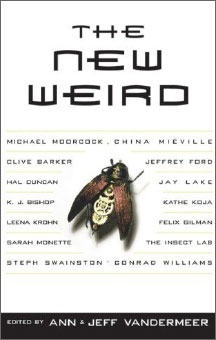 |
 Edited by Ann & Jeff VanderMeer
Edited by Ann & Jeff VanderMeer
The New Weird
Reviewed by: Mario Guslandi © 2008
Tachyon Publications
US First Edition Trade Paperback
ISBN 978-1-892391-55-1
414 pages, $14.95
Publication Date: 03-01-2008
Date Reviewed: 03-27-2008
Index:
Fantasy
Horror
Science Fiction
Mystery
General Fiction
On April 29, 2003 in his TTA Message Board M. John Harrison wrote:
The New Weird. Who does it? What is it? It is even anything? It is even New?
Editing the anthology 'The New Weird', Ann & Jeff VanderMeer have tried to answer these questions by assembling a number of samples of so-called New Weird fiction, as well as some critical essays and comments by writers, editors, critics.
It appears that the New Weird is just a form of speculative fiction attempting to mix fantasy, horror and SF genres, and creating stories set in bizarre urban spaces populated by physically grotesque characters. Therefore the New Weird supposedly takes the readers in a world they don’t expect, blending ancient mythologies and modern culture. On the other hand the existence of The New Weird as a subgenre, a movement or a school remains questionable. Most likely it is an argument between a bunch of writers who read each other, who sometimes influence each other, sometimes struggle against that influence.
I’m not a literary critic but a mere reviewer and I don’t feel qualified to give a learned opinion about the existence of The New Weird as a subgenre and to define its borders.
The only unquestionable common ground for the stories included in this anthology is weirdness, no doubt about that. But, at the end of the day, what really counts for the reader and the reviewer is the quality of the fiction, regardless of genre labels or literary conundrums.
Thus, being aware of the risks I’m taking by saying so, I must declare that some of the alleged masterpieces featured in this anthology as fine examples of The New Weird are simply weird, nothing less and nothing more, and often remain boring exercises in weirdness.
This is my feeling about pieces such as Steph Swainston's 'The Ride of the Gabbleratchet' and Alistair Rennie's 'The Gutter Sees the Light that Never Shines', to mention just a few, and with my apologies to the authors.
In Brian Evenson's 'Watson’s Boy' a young man is obsessed with rats and dust and collects hundreds of keys. A weirdo, to be sure… Nice prose, weird atmospheres but nothing happens throughout the piece, there’s no attempt to build even the shadow of a plot.
Fortunately there are some stories with a head and a tail as Clive Barker's classical 'In the cities, the hills' an original, imaginative piece where a gay couple witnesses and gets involved in a peculiar, superhuman battle between two villages in the former Yugoslavia. Weird indeed and excellent.
Another winner is Michael Moorcock's 'Crossing into Cambodia' a not-too-weird, masterful war tale narrated in a superb style , depicting the horror of the nuclear and the depths of the human soul.
'The Braining of Mother Lamprey' by Simon D Ings is a very weird, enjoyable tale of witchcraft, oracles and necromancers.
In the cute 'The Neglected Garden' by Kathe Koja a woman dismissed by her lover turns into a living garden. Isn't that weird?
Jeffrey Ford contributes 'At Reparata', where a weird kingdom inhabited by weird people provides the setting for a delightful fantasy tale describing how even well-meant magic can elicit disaster.
Some contributions are worth mentioning mainly because they provide a faithful interpretation of one of the canons — or mannerisms — of The New Weird, i.e. the creation of strange (meaning weird…) imaginary cities such as M. John Harrison's 'The Luck in the Head', Jeffrey Thomas' 'Immolation', Jay Lake's 'The Lizard of Oooze' and Leena Krohn's 'Letters from Tainaron'.
The last section of the book, aptly named "Laboratory", is represented by a Round Robin entitled 'Festival Lives' by Paul Di Filippo, Cat Rambo, Sarah Monette, Daniel Abraham, Felix Gilman and Conrad Williams, taking place — once again — in a weird city threatened by terrorism.
The piece has a distinctly uneven quality, being remarkable only for Di Filippo's excellent start describing the arrival of the terrorist and for the splendid ending penned by Williams.
Incidentally those are the less "weird" portions of the collaborative story. Just a coincidence?
|
 |
